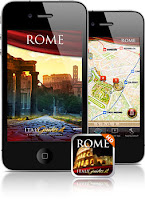A couple of weeks ago we traveled to Italy - one of our
favorite vacation spots in the world. Based on some advice from friends, we chose
to visit Rome, and travel to Napoli, Sorrento and the Amapfi coast. Many words were written on this beautiful area
in southern Italy, so I will skip the scenery descriptions. I do want to talk about the “travel
experience”, especially with an iPhone in my pocket.
Our first joint vacation in Italy was about 30yrs ago. We armed
ourselves with maps of every city we planned to visit, purchased a road atlas,
and carried a couple of Michelin guide books. We also made frequent visits to
tourist information offices along the way.
Since we don’t like to “commit” to hotels every day of the trip, we
stayed in various hotels which we either looked up in the Michelin guide while
driving, or simply stumbled across. We stayed in some good hotels, and there
were ones where we could hardly wait for sunrise to rush out.
The most challenging part of my preparation for our recent
trip was figuring out the cellular voice & data strategy. Using our Israeli
phones abroad would have cost a fortune, especially since I planned to use the
Internet extensively. My idea was to purchase local SIM cards in Italy, but I
wasn’t sure how well they would work with my US purchased iPhone.
Furthermore, I needed to keep one phone with an Israeli
number, in case a family member needs to reach urgently. I ended up carrying 5
phones: two iPhones and three regular phones, plus a power adapter for each
phone. I am sure the pile of phones in my luggage raised an eyebrow with airport
security inspectors...
Before we left Israel, I loaded a bunch of Mobile Apps on my
iPhone. Things like: Google Maps, Bookings.com, TravelAdvisor, Rome guide,
Yelp, etc. I planned to use those apps regularly during our trip.
Fortunately the array of phones I carried proved to be overkill.
I purchased prepaid SIM cards in Rome, with unlimited data access and 250 voice
minutes. They fit easily into our iPhones, and within minutes we were online
with the local Vodafone service. Once
cellular and data communication were in place, we embarked on our trip and the
real adventure begun.
Google Maps was my first pleasant surprise. I used it while
strolling through the streets of Rome, or driving to our next destination.
Rather than unfold a paper map, struggle to find a legible street or road sign
and try to locate myself on the map, I simply pulled out the iPhone and
launched Google Maps and pressed a button to locate myself. Getting to a place
of interest, or our next destination was simple: punch the address or search
for it by name, then let GoogleMaps guide you there – on foot, by car, or using
public transportation.
My next pleasant surprise was the Bookings.com app. Since
our trip plan was rather flexible, we didn’t book all the hotels in advance. I remember
the struggle to find a hotel room in the ‘old days’. However with Bookings.com
it was as simple as pushing a button: launch the app, enter the desired area, and
fill in some search terms – start rating, price range, etc. Next thing you know, a list of hotels with
vacancies pops up! You get a ton of information about each hotel, including location
on the map, travellers’ reviews and photos of the hotel insides. With a couple
of clicks I reserved our room of choice and got a confirmation number and an
email. We booked 4 different hotels while on the road, and each one was a home
run.
I did use TravelAdvisor and Yelp, mainly to locate nearby attractions
and restaurants. TravelAdvisor was OK when it came to major attractions; however
I got a rather small number of restaurant suggestions from either app. The
hotel reception was a better resource than any app we used. When it came to
restaurants, we used the age-old method of either following a “human
recommendation”, or simply walk around and stumble across a restaurant we
liked. This retained a bit of “human touch” in our trip.
Staying in touch with our family was a breeze as well. With kids
in the US and in Israel, using a regular phone calls would have been an
expensive hassle. WhatsApp and iMessage came to the rescue. We could easily
exchange messages with our kids, and even share photos with them on the fly. Whenever
we arrived at a hotel with WiFi, we used FaceTime or Skype for a video chat
with our kids.
And let’s not forget Facebook. Using the iPhone camera I
took snapshots at stops along our trip, and posted those on Facebook with a
brief comment. After all, our friends and family should all know we are in
Italy and having fun ;-)
Last but not least, I had continuous email access, avoiding
the need for the infamous auto-reply message: “I am currently traveling with limited access
to my email. I will reply to your message as soon as I can”. Yes, I was
traveling, but I had access to email. And I could reply immediately– if I chose
to. After all, I was on a vacation…
I know that using a smartphone on the road sounds trivial to
some of you; and I actually understand how the technology works. Still, it felt
like magic to me. I am not sure how I could go back to paper maps, guide books,
tourist information booths and postcards. iTravel is the way to go!

No comments:
Post a Comment